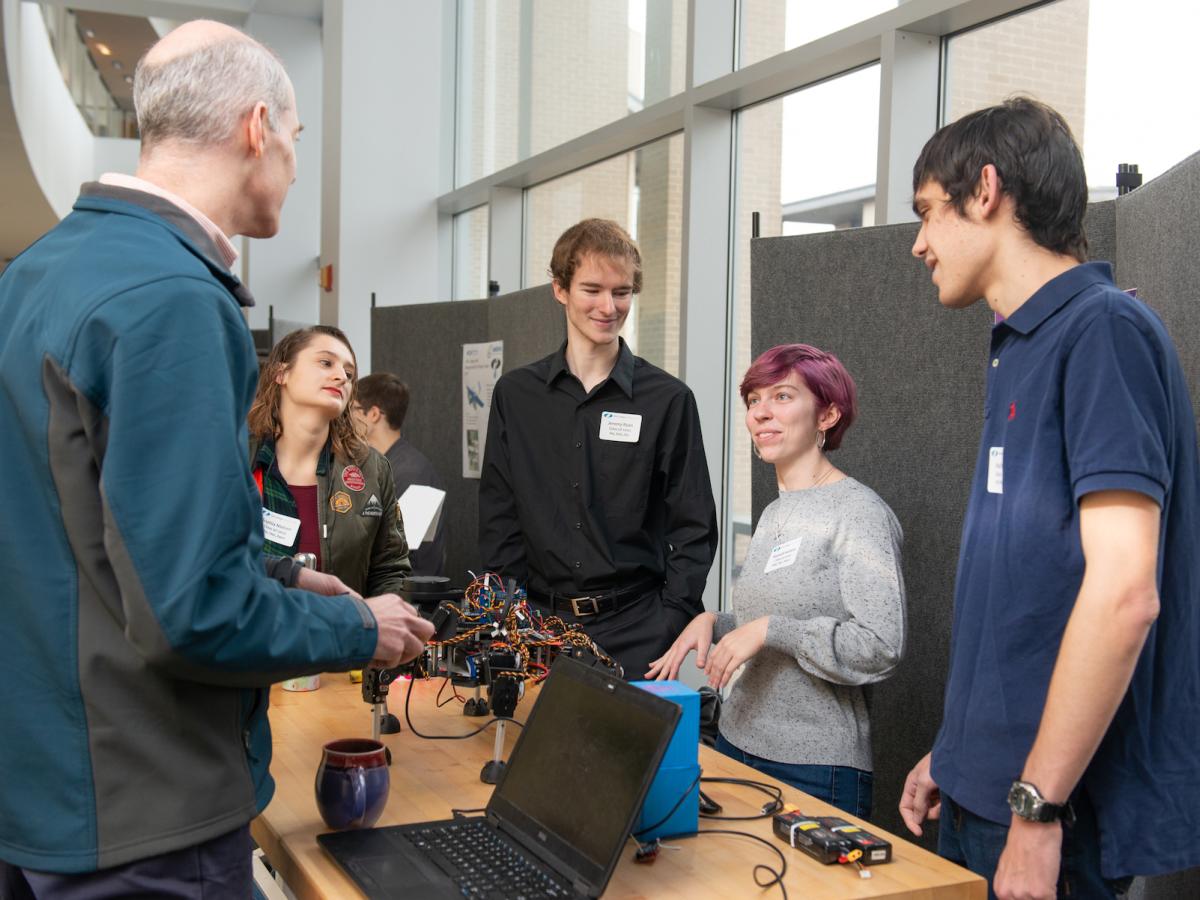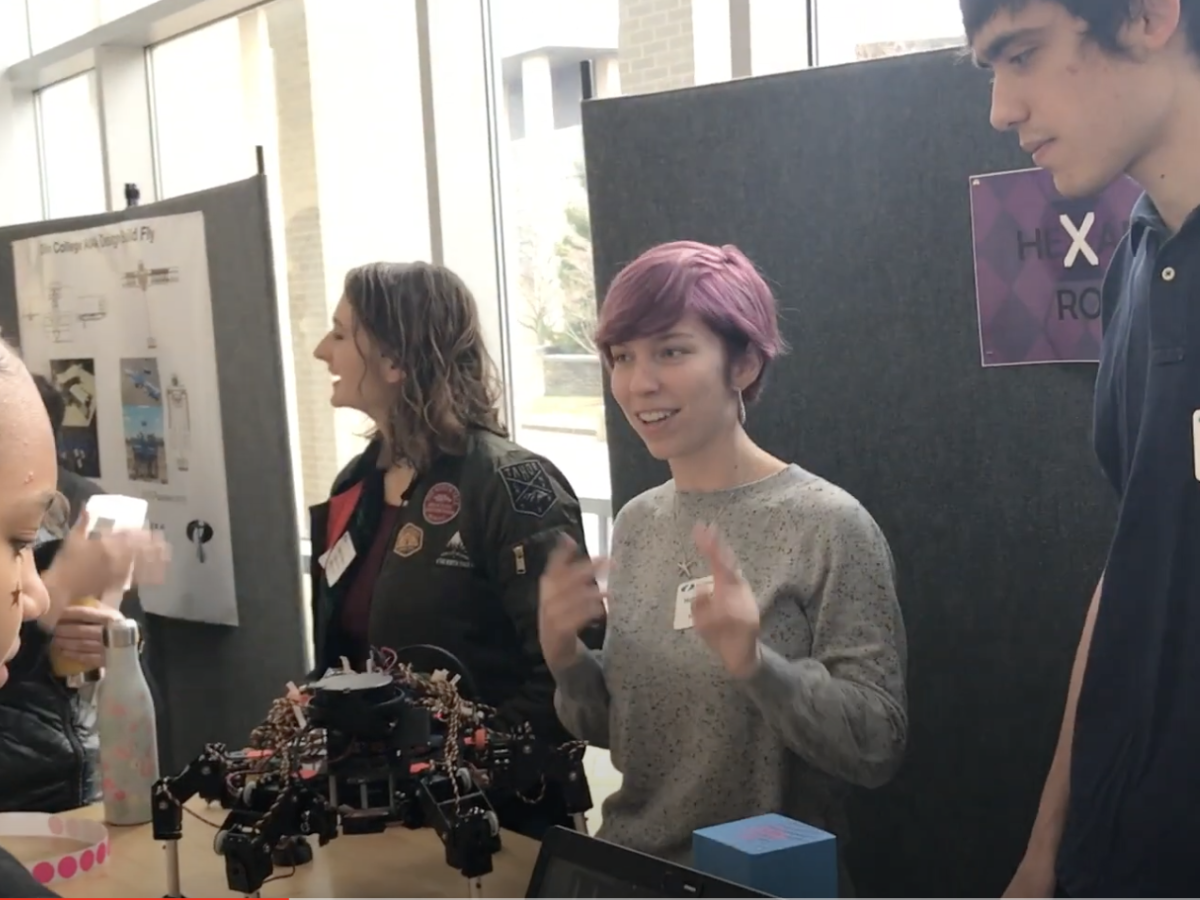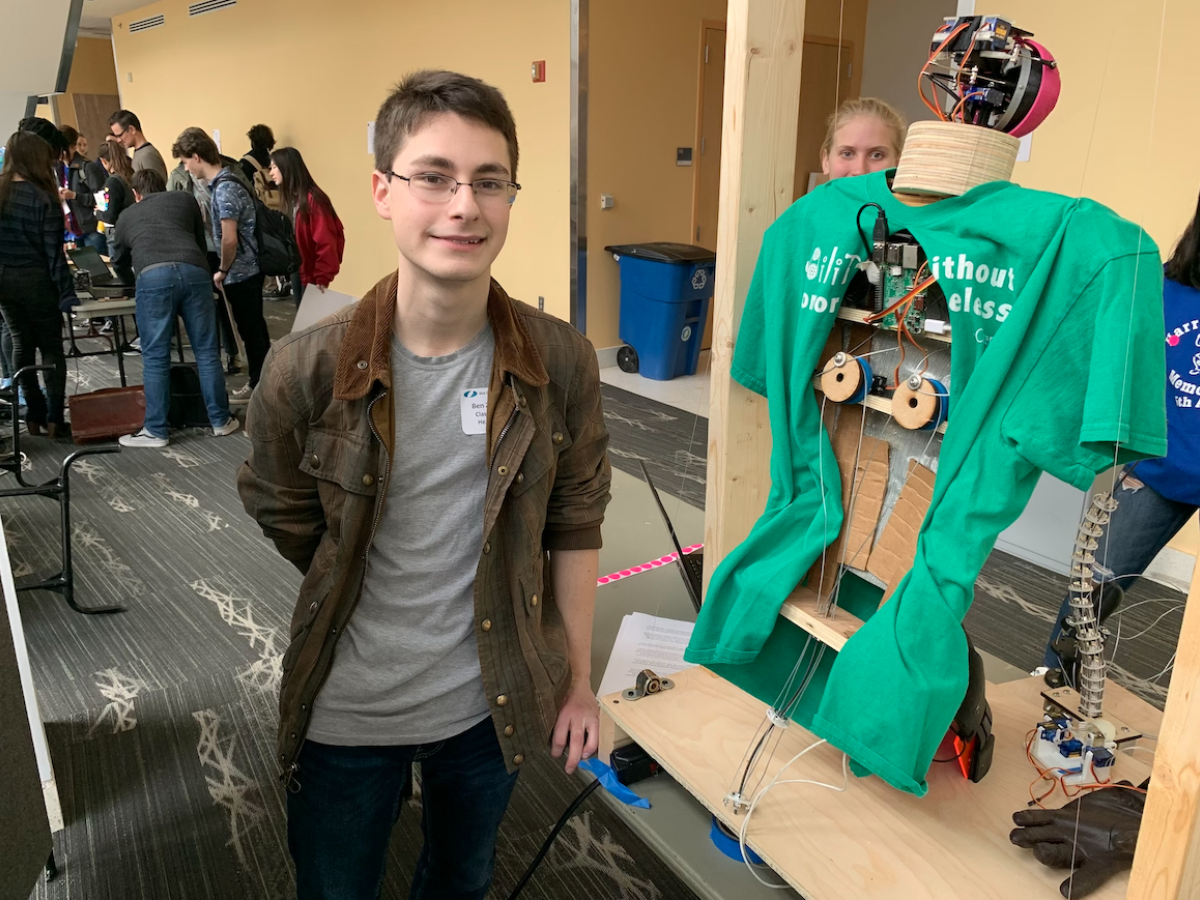The Olin community gathered in the Academic Center on Monday, December 16, 2019 to take in the sights and sounds of Olin’s fall Expo.
At this end-of-semester celebration of student learning and achievement, students share their project work through poster sessions, interactive demonstrations and artistic performances.
This year, Olin students presented over 90 projects and welcomed guests from Changemaker Academy in Waltham, MA, student families, faculty, staff and friends of the college. Upon entering the Academic Center, crowds of enthusiastic and curious Expo visitors were greeted by the hum of animated voices and music, as well as colorful—and sometimes extremely tall—visual displays.
Projects ranged from a wall climbing robot that uses mechanical switches to scale metal surfaces to a device that tries to predict seizures to exploring ways to reform the Boston justice system with data science and just about everything in between.
Click here for a full listing of student presentations and performances.
Click here for a photo slideshow!
Read on for more about some select presentations!
Hexapod Rover:
At one table, visitors were treated to walking, dancing hexapod rover from Olin’s RoboLab. Student presenters Jeremy Ryan ’20, Paul Nadan ’20, Hannah Kolano ’20 and Sophia Nielsen ’20 demonstrated its groovy moves— by mapping the accelerometer to its orientation, the rover adjusts its center of gravity and boogies on its six legs and nineteen servo motors.
The design for the hexapod’s feet was inspired by goat’s feet. The bottoms are squishy, allowing the rover, like a goat, to gain traction and traverse uneven terrain.

RoboLab students present their hexapod at Fall Expo 2019.

WATCH the Hexapod in action!
Animatronic Control Mechanisms:
During senior Benjamin Ziemann’s independent study, he designed and built an animatronic mechanism with a blinking, motion-detecting “eye” and a tentacle. In part inspired by his summer internship at Disney, Benjamin described this not only as a hobby, but also the base of future exploration.
“There are definitely people who look at a bridge and think wow, that’s awesome, I wonder how they did that?” he explained. “But if you bring someone’s favorite character to life or make something look like it’s a living creature, that’s a lot more likely to get people asking questions about how does this work and get them interested.”
One of the best parts of the project was figuring out design solutions “on the fly” when things didn’t work out quite right.

Senior Benjamin Ziemann presents an animatronic mechanism at Fall Expo.
PortaBraille:
Team “dot dot dot” built this cost effective, portable, and user-friendly braille printer for Principles of Engineering (PoE). “The premise of the class is: you can make anything! It can be very user-oriented, or it can be super whimsical.” said Megan Ku ’22. “We really wanted to do something that had a user group, and where we could get feedback and do iterations.”
The team worked with a braille reader to test the machine’s effectiveness, and even learned to read some braille in the process. The fact that it works is really exciting: “We’re really proud of that.”
Cerebral Palsy Device Research:
Students are working in LAIR (Laboratory for Adaptation, Inclusion, and Robotics) to create a soft-grip robotics glove to help kids with spastic cerebral palsy move their fingers to allow them to strengthen their hands, grip objects and play.
This semester they worked with a 13-year-old girl and her family to develop this technology with the hopes that eventually it will enhance her physical therapy. “It was so great working with Maeve,” said Dylan Merzenich ’22 and Sam Coleman ’23.
Public Interest Technology (PInT):
PInT is a new project team on campus focused on using technical skills to do good in the world. Students hope to encourage the spread of public interest technology on Olin’s campus. PInT has spent the semester building skills the club needs to tackle projects for the Crotched Mountain School.
Next semester, they plan to work on a BIGmack button—a button that can play a pre-recorded message. So far, they have taken apart a Staples easy button and are figuring out what kind of components need to go into the project. “Eventually we will figure out how to make it cheaper and more durable,” explained Ruby Eisenbud ‘23.
Club members hope to “encourage conversations about how we can use and make technology that’s ethical and that helps people, rather than just serves to make a profit,” and hopefully will get students involved in those career pathways.
Chameleon Play Experience:
The Design Nature team of Gati Aher ’23, Simon Kemp ‘23, Loren Lyttle ‘23 and Hazel Smith ‘23 created a bug-collecting game for fourth graders. Valuable lessons learned through the design process, they reflected, were the teamwork and coordination needed to carry out the project. They also learned how to use materials effectively to maximize their budget of $100, which often involved being resourceful and upcycling materials when possible.
After constructing an 8-foot-tall tree out of cardboard, the group designed a chameleon with a mechanical, magnetized tongue that shoots out to catch tiny wire bugs. The chameleons, whimsically painted with flour- and milk-based paint, are operated by one blindfolded student and directed by another (holding a giant chameleon eye) to capture and “eat” the bugs on the tree.
“It was just a really fun day,” said Loren, describing the Design Nature presentation day. “The kids thought it was super cool, and we got some good feedback from them.”
Another lesson Loren has learned through this project and during his time at Olin: “Never be afraid to go big,” whether in scale or ambition!